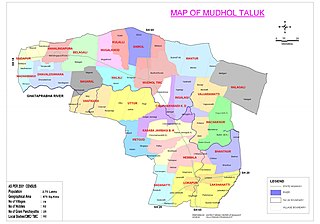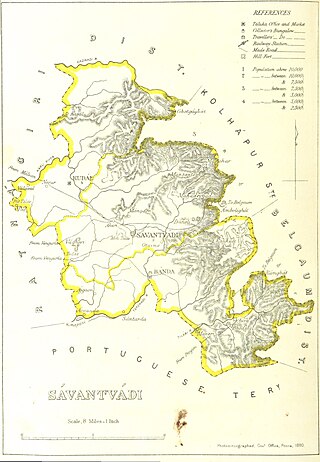
The Mudhol Hound, also known as the Caravan Hound, is a breed of sighthound from India.

Mudhol is a city previously known as "'Muduvolalu"' in the Bagalkote District in the northern part of the South Indian state of Karnataka. It is about 60 km (37 mi) from the district headquarters of Bagalkot and 25 km (16 mi) from subdivision of Jamakhandi. It is famous for a breed of dog known as the Mudhol Hound, and for its wrestling tradition. Mudhol State was ruled by the Ghorpade-Maratha royal family.

Miraj Senior was one of two Maratha princely states during the British Raj: 'Miraj Junior' and Miraj Senior. The two states separated in 1820. It was under the southern division of the Bombay Presidency, forming part of the southern Mahratta Jagirs, and later the Deccan States Agency.

Jamakhandi is a city in Bagalkot district in the Indian state of Karnataka. It was the capital of the former princely state of Jamkhandi. It is located 90 km towards west from district headquarters. It is the first princely state to merge in constituent India based on demand to make Jamkhandi as a district. It is a subdivision of the district. Mudhol, Bilagi, Rabakavi-Banahatti, Teradal and Jamakhandi taluks come under Jamakhandi subdivision.

Shrimant Maharaja Sir Pratap Singh Rao Gaekwad, who belonged to the Gaekwad dynasty of the Marathas, was the ruling Maharaja of Baroda. He succeeded to the throne upon the death of his grandfather Sayajirao Gaekwad III in 1939. In 1947, British India was partitioned into two independent dominions, and Pratap Singh acceded his state to the Dominion of India. By 1949, Baroda had been merged into India.

Kolhapur State or Kolhapur Kingdom (1710–1949) was a Maratha princely State of India, under the Deccan Division of the Bombay Presidency, and later the Deccan States Agency. It was considered the most important of the Maratha principalities with the others being Baroda State, Gwalior State and Indore State. Its rulers, of the Bhonsle dynasty, were entitled to a 19-gun salute – thus Kolhapur was also known as a 19-gun state. The state flag was a swallow-tailed saffron pennant.

Jath State, was one of the non-salute Maratha princely states of Deccan States Agency, one of the former Southern Maratha Jagirs. Jath State and Daphlapur State were the only two states belonging to the Bijapur Agency under the Bombay Presidency, which later became part of the Deccan States Agency.

Aundh State was a Maratha princely state during the British Raj, in the Deccan States Agency division of the Bombay Presidency.

Bhor State was one of the 9-gun salute Maratha princely states of Deccan States Agency. It was the only state belonging to the Poona Agency under the Bombay Presidency, which became later part of the Deccan States Agency. Along with Akkalkot State, Aundh State, Phaltan State and Jath State, it was one of the Satara Jagirs. The state merged with the newly independent Indian union in 1948.

Sangli State was one of the 11-gun salute Maratha princely states of British India. It was under the Kolhapur-Deccan Residency in the Bombay Presidency, and later the Deccan States Agency.

The following list includes a brief about the titles of nobility or orders of chivalry used by the Marathas of India and by the Marathis/Konkanis in general.

Dewas Senior was established by Tukoji Rao I Pawar during the Maratha conquest of Central India. It was a 15 Gun Salute Maratha princely state. On 12 December 1818 it became a British protectorate.

Savantvadi State, also spelt Sawantwadi ruled by the Sawant Bhonsale dynasty was one of the non-salute Maratha princely states during the British Raj. It was the only state belonging to the Kolaba Agency under the Bombay Presidency, which became later part of the Deccan States Agency. Its capital was at Sawantwadi, in the present-day Sindhudurg district of Maharashtra.
Events in the year 1855 in India.
Events in the year 1854 in India.
Events in the year 1851 in India.
Ghorpade is a surname and family name found among Marathas, Marathi Brahmins, Mahar and even Chambhar caste in the Indian states of Maharashtra and Karnataka and may refer to members of the Ghorpade Dynasty.
Baka Bai (1774-1858) was a Maratha stateswoman and favourite wife of Raghoji II Bhonsle, the king of Nagpur. After her husband's death, she played a key role in the intrigues at the royal court of Nagpur.













